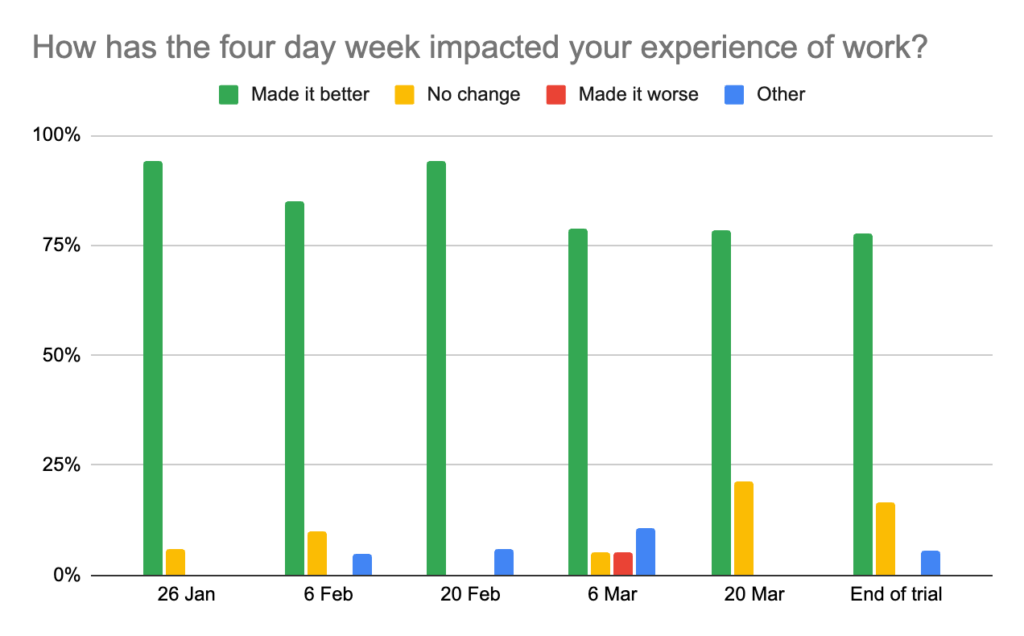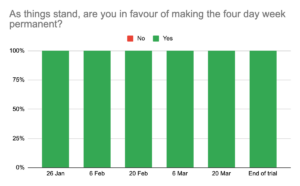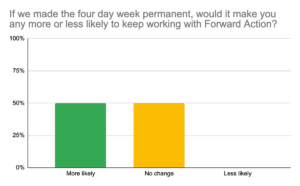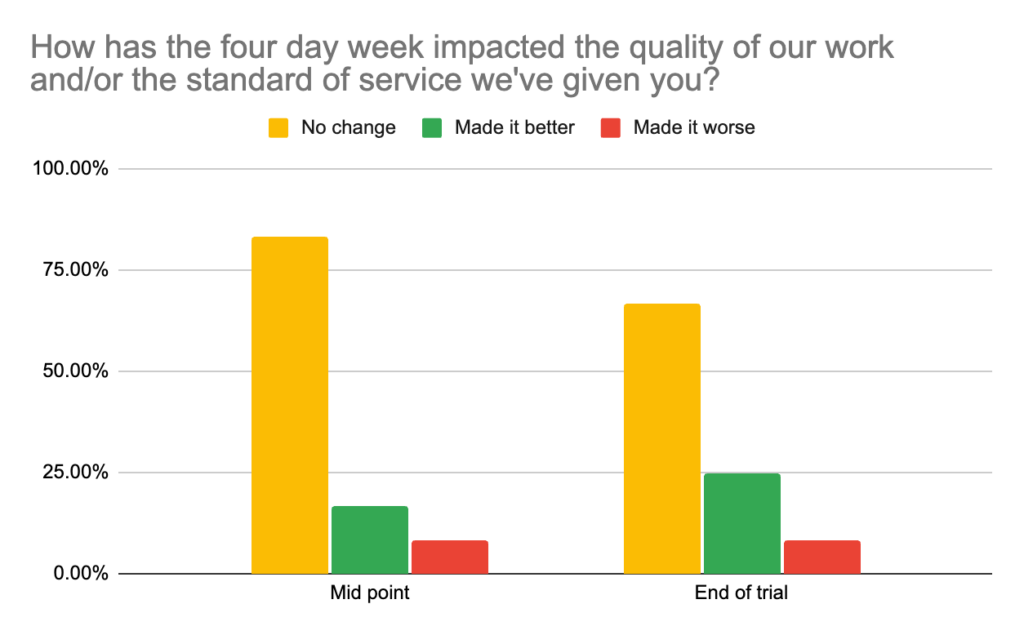In January 2023, we launched a three month trial of a four day week, on full pay, for everyone at Forward Action. Now our trial is finished we wanted to report back on what we did, how it went, and our lessons for other organisations thinking about trialling a four day week themselves.
Why did we decide to trial a four day week?
There were two key reasons behind our decision to trial a four day week:
- We’d seen the improvements to wellbeing, productivity and creativity for staff already working part time, and wanted to extend those benefits to the whole team (more on this in our blog announcing the trial)
- As we prepared to leave Forward Action and hand over to our team and new CEO, we wanted to ensure we were leaving them an organisation in the best possible shape. That meant:
- Making some operational changes; simplifying our organisational structure, delegating more responsibility and power around our financial sustainability to our team, and improving our efficiency
- Tackling lingering post-pandemic burnout amongst our colleagues and ensuring Forward Action could hold onto its brilliant team long term
We viewed a four day week as the most powerful tool available for a) dramatically and permanently improving our team’s wellbeing and b) incentivising everyone to be proactive in reshaping the organisation and taking on extra responsibility. Rather than a risk, we in fact saw the four day week as our best route to leaving Forward Action with the strongest possible foundation for long-term success.
The structure of our trial
Our trial was simple in structure:
- It was three months long, running Jan – Mar 2023
- During it, we moved from working 37.5 hours over five days to 30 hours over four
- Everyone worked Mon to Thurs, with Friday off
- We set up an on call system to enable partners to contact us with emergencies on Fridays, and each of us took it in turns to staff the system
Our criteria for success
Our first step was to define our success criteria for the trial. If the four day week was going to succeed, we knew we had to prove that we could continue to do as good a job for our partners (if not better), deliver the same amount of work as we did on a five day week, and see tangible benefits to our team’s wellbeing.
Our success criteria were divided into three camps:
- team – because of benefits to their working experience, 75% of the team want to keep the four day week beyond the trial
- partner – costs do not go up up for partners; results and partners’ experience of working with us stay as good or improve; projects are delivered as quickly as before; we’re able to effectively respond to emergencies on Fridays using our on-call system
- operational – we are able to do the same amount of partner work in four days as we did in five, enabling us to hit our income targets
We wanted to regularly evaluate our performance throughout the trial and make improvements as we went along. To enable this, we set up bi-weekly surveys for the team, a halfway-point survey for partners, and collected operational and financial data monthly. We then did one last survey of our team and partners at the end of the trial to give us our final results.
Preparing for the trial
With our success criteria in place, we spent around four months preparing for the trial. Our primary goal was to answer this question: “How can we get as much – or even more – high quality partner work done in four days as we did in five?”
We did three things to achieve this:
- Reshaped our teams and redistributed power and responsibility. We moved from a complex structure of overly specialised roles and top-down planning to more nimble cross-functional teams with greater autonomy over planning and delivering their work
- Cut back on low-value internal time to make space for additional partner work – e.g. shortening or getting rid of internal calls that weren’t useful enough and scrapping the time-consuming working groups we used to set policies
- Find ways to get even more done for partners the time available for their projects
To help us do this, we adopted the “lean” framework across the whole organisation. Lean is a philosophy of work that applies five principles to help teams maximise the value of their work for customers, cut out waste, and streamline tasks to improve efficiency. We ran weekly team-wide sessions in the months running up to the trial to identify where we could make our work leaner, giving us a roadmap for how to deliver the same amount of work in four days as we did in five.
The results
Overall, the trial was a great success. We hit all of our criteria, in some cases even exceeding our expectations of what would be possible. Based on this positive outcome, we’ve now extended the trial until the end of 2023. This will give us a full year’s worth of financial data before we make a final decision whether to permanently adopt the four day week for 2024 and beyond.
Team’s wellbeing and experience of work
The team’s feedback about the four day week was overwhelmingly positive, with over 75% saying at the end of the trial that it had improved their experience of work. Team members reported better mental health; more energy, focus and productivity at work; a greater capacity to try new things and take on more responsibility; a better work life balance; and lower levels of stress and burnout.

As anticipated, some team members reported that their working days felt more intense as we delivered five days of work in four. However, they judged that this was outweighed by the benefits of the four day week. As a result, support for keeping the four day week was unanimous right the way through the trial. Our team are voting with their feet, too; staff retention has been 100% in the 9 months since we started preparing for the trial.

Partners’ experience

Our number one success criterion for the trial was that the quality of our work and partners’ experience of working with us stayed just as high – or even went up. In our anonymous partner surveys, we were pleased that not only did most partners see no negative impact on our work, several in fact felt it had improved. Those who did attributed it to the energy and productivity of our team:
“If anything, having a better work/life balance likely ensures productivity/happiness is higher – which is directly beneficial for us. Everyone I’ve worked with at FA has been so on it, fantastic to work with, and seems really engaged and enthusiastic, so there must be something in it!”
“It has already resulted (and will continue to result) in better/happier/healthier/effective customer service, and a more efficient way of working for all parties involved.”

Alongside the positive feedback, one partner in each survey felt that the trial had made their experience worse. To address this, they offered some really helpful suggestions around a mechanism for answering urgent questions on Fridays for projects with very compressed timelines. We’re looking at tweaking our Friday on call system to facilitate this.
On balance, however, feedback from partners was positive. This gave us the confidence that we could continue with a four day week without damaging our partners’ overall experience of working with us (thank you to all the partners who offered their feedback – we hugely appreciate it).
Financial criteria
Off the back of reshaping our teams and adopting lean working, we found we were indeed able to deliver enough work to hit our income targets, despite working four days rather than five. In fact, we even slightly exceeded our income targets for the quarter.
Lessons for other organisations
There are five key lessons we’d offer from our experience trialling a four day week:
1. It’s more possible than you think. When the idea of a four day week was first suggested by members of our team, our response was, I suspect, typical of many leaders; we’d love to do it, but it’s just not possible for this organisation. However, once we gave ourselves the remit to think creatively about how to drive the efficiency needed to make it work, it became clear that not only was it possible, it was absolutely the right path to take for our organisation.
2. Being able to define and measure valuable work is critical. For a four day week to succeed, you need to know you can deliver as much valuable work in four days as in five. To do that, you need to know and be able to measure what’s valuable to you. This is something a lot of organisations struggle with, but it’s a key first step towards making a four day week possible – and, indeed, towards being able to really maximise the effectiveness of what your organisation is doing day-to-day, four day week or no.
3. It’s worth planning it properly – but it is time consuming. The success we saw in our trial was in large part down to the careful planning we put into it; without that, we know we wouldn’t have seen all the benefits we did. Nonetheless, the planning did take a fair amount of leadership capacity – around 3 days a week between the two of us for four months. The outcome has justified that time investment many times over, however.
4. A four day week can be a tool to drive transformational change, fast. By harnessing the positivity and unified team focus created by the upcoming trial, in just four months we were able to restructure our organisation, embed a new philosophy of work into our culture, and overhaul the distribution of power and responsibility within our team. If you’re considering a four day week trial, see it as a once-in-a-generation opportunity to achieve major change in your organisation. What do you want to do with it?
5. It can be a game changer for team morale, wellbeing and retention. The results we saw blew us away and, crucially, have lasted. Our team are still happier, more productive and more motivated. Their mental health is better and they’re feeling less burnt out. And, as a result, they’re choosing to stay and keep applying their exceptional talents at Forward Action, hopefully for many years to come.
Get in touch
If you’d like to learn more about our trial, or chat to use about doing some digital mobilisation work together, please do get in touch – hello@forwardaction.uk. We’d also be really happy to chat to anyone considering a trial to share our experiences and help you think through the considerations for your own context.
We hope you’ve enjoyed our webinar run down. Want to join our next webinar? Get our emails.
We know you must have some burning questions, here are some we talked through in the webinar:
Q: Do you think it’s important to have the same one day off, or is it better to have some of the team take different days off so there’s still cover five days a week?
We chose to have the same day off to allow for more collaboration between Monday and Thursday, and to minimise the stress of having to organise cover when team members have different days off.
However, you should do whatever works for your organisation to get to your goal of delivering the same work in four days – we recommend asking your whole team to see what they prefer!
Q. How many billable hours per day did each person work before adding an extra one?
While billable hours vary for different members of the team, for the majority of co-owners who were doing five billable hours before, the aim was for them to do six hours. This was made possible by reducing our internal time and finding more efficient ways of doing things to free up time for billable work.
Q. Was there any change to your benefit package, especially holiday allowance?
We went from 25 days of holiday per year, to 20 days – but with the extra day off each week it means co-owners can still book off the same number of weeks holiday in the year!
Q. How do salaries change for a four day week, when you have some people already doing reduced hours?
Before the four day week trial, nearly half of Forward Action’s team members were working four days a week pro rata. During the trial, everyone went up to a full time salary. Our leadership team were all working four days a week, and they went up to 90% of the full time salary only, to take some of the financial burden.
Q. We’re an organisation that tenders and bids for contracts. We are concerned that a four day week would make us less competitive in terms of increasing hourly wage for staff. What is the solution to this?
The goal of the four day week is to do five days’ work in four days. That means when you’re tendering, you’re not saying that “you’ll pay us the same as another organisation but get 80% less delivered”.
Instead, your pitch should be: “we will deliver the same work but in less time”. Your goal is to figure out how to achieve that!
Q. How do you avoid people working Fridays regardless of the four day week?
We empower each of our team members to take ownership of their time, so if someone really wants to log on for half an hour on a Friday then they’re allowed to do that, but we encourage them to flag with their managers and take the time back at another point in the week.